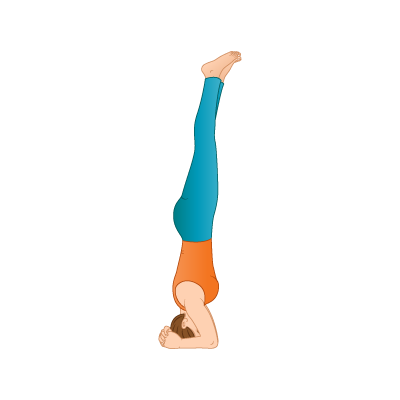Headstand
Sirsasana

STEPS
Begin in vajrasana (seat to heels). Bring the fore arms down to the ground. Interlock the fingers and cup the hands together in a V shape to support the head. Place the crown of the head between the thumb mounds. Straighten the legs and walk the feet towards the head until the hips are over the shoulders. Now extend one leg straight up and then the other. Lift up through the torso and legs. To come down, lower one leg and then the other to the ground. Bend the knees and sit back into child pose.
TEACHER QUEUES
VISUALIZATION COMMENTS
Headstand is Tadasana (mountain pose) upside down. You might begin practicing mountain pose against a wall bring the hips, shoulders and heels into alignment. For beginners, it is also best to practice head stand against the wall. The arrangement of the arms in this pose makes a stand for the head– like a tree stand, so try phrases such as grounding the hands and forearms to make a firm support. The hands should clasp the sides of the head, like the bolts of a tree stand, holding the weight of the trunk and in this case supporting the neck.
TECHNICAL COMMENTS
The head, forearms and elbows form a triangle on the ground making a firm support or stand for the crown of the head. To do this effectively, the forearms should be placed shoulder width. You can measure this distance by crossing the arms. To prevent the wrists from collapsing bring one pinkie finger in front of the other and place the thumbs in a V shape. The crown of the head is the highest point of the head. This can be measured by placing a block on the top of the head to see where it balances. Place the crown of the head between the thumb mounds and hold with a firm grip. There should not be any pain in the head or neck. To engage the shoulders, press the edges of the hands, forearms and elbows into the ground. Contract the muscles of the back. Walk the feet forward until the hips are over the shoulders. Extend one leg over the hip and then the other. Draw the front ribs in and the tail bone down to lift up through the core and legs. Keep lifting up through the arches of the feet to bring the spine and legs in one vertical line.
BENEFIT COMMENTS
- Strengthens arms , shoulders and neck
- Improves breathing
- Relieves leg and back pain
- Strengthens core muscles
- Relieves fatigue, insomnia, stress and mild depression
- Improves nervous system
- Improves balance
WATCH OUT FOR
- Collapsing wrists (Bring the hands and thumbs closer together)
- Collapsing shoulders (place a strap around the forearms)
- Neck pain (come out of the pose!)
- Hips in front or in back of shoulders (practice against a wall)
- Fly away legs (keep one leg straight and one to spring up and/or practice against the wall)
CONTRAINDICATIONS
- Neck injuries
- Headache or migraine
- High blood pressure
- Heart ailments
- Pregnancy
- Menstruation
- Glaucoma or eye problems
- Ear infections
MODIFICATIONS
- Dolphin or Puppy are both beginner poses which provide entry into head stand once the shoulders and core are strong enough to support the weight of the body. Students might begin in down dog or on all fours and then proceed as above but keeping the feet on the ground. This is a good alternative for pregnancy yoga.
- Practicing headstand against a wall will help students to ease into this pose and fine tune their balance and alignment. Place the interlocked fingers against the wall to support the wrists. Walk the feet towards the head until the hips touch the wall. Then try to extend one leg and then the other against the wall.
- Head stand with knees bent – Begin with the placement of head and arms as detailed above. Slowly walk both feet towards the head until the hips are over the shoulders. Contract the back muscles and engage the abdominals. Slowly lift both feet off the ground, bringing the knees to a vertical position. Slowly straighten over the shoulders. Bring the knees over the shoulders with lower legs behind and parallel to the floor. The feet may be brought to rest against a wall.
- Place a blanket under the head to ease any discomfort on the skull
- Place a strap securely around the upper arms to hold them in alignment under the shoulders
VARIATIONS
- Headstand lotus pose (padmasana sirasana). Begin in sirasana. Slowly fold legs into ½ lotus of lotus (padmasana)
- Supported head stand pose (salamba sirasana). Begin in hands and knees (marjaryasana). Bring the crown of the head down onto the floor between the hands. Walk the hands back so they are placed underneath the shoulders making a triangle shape or tripod stand. The elbows should be bent with the forearms parallel to the floor. Walk the feet to the hands and lift the feet off the ground. Bring the legs parallel to the floor. Find your balance point. Continue lifting the toes up towards the sky.
YOGA COUNTER POSES
- Child pose (balasana)
- Seated forward fold (paschimottanasana)
- Mountain pose (Tadasana)
- Savasana
Written By: Brenda Hamlet RYT 200
Brenda is a yoga teacher and journalist in Oxford, England. More information about Brenda can be found at www.pret-a-yoga.com



